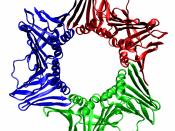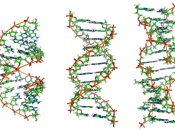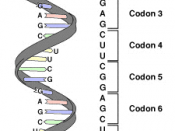Outline on Iportant subjects in DNA and RNA -
Nucleic Acids and Protein Synthesis
7-1 DNA
Cells 'know' how to how to produce ATP, how to build cilia and centrioles, how
to produce membranes and enzymes.
A program, or code, in living cells must be able to duplicate itself quickly and
accurately and must also have a means of being decoded and put into effect.
The Genetic Code
Biologists call the program of the cell the genetic code. The work genetic refers
to anything that relates to heredity. The genetic code is the way in which cells store
program that they seem to pass from one generation to another.
Transformation
When a strain of information is passed to another, it is called transformation.
The Transforming Factor
DNA is the nucleic acid that stores and transmits the genetic information from
one generation of an organism to the next. DNA carries the genetic code.
Bacteriophages
Some virusus are known as bacteriophages which mean bacteria eaters.
Bacteriophages are composed of a DNA core and a protein coat. They attach themselves
to the surface of a bacterium and then inject a material into the bacterium. Once inside
the bacterium, the injected material begins to reproduce, making may copies of the
bacteriophage. Soon the bacterium bursts, and several hundred bacteriophages are
released to infect other cells. Because the material injected into the bacterium produces
new bacteriophages, it must contain the genetic code.
The Structure of DNA
DNA is a polymer formed from units called nucleotides. Each nucleotide is a
molecule make up of three basic parts: a 5-carbon sugar called deoxyribose, a phosphate
group, and a nitrogenous, or nitrogen-containing, base.
DNA contains four nitrogenous bases. Two of the nitrogenous bases, adenine and
guanine, belonging to a group of compounds known as purines. The remaining two,


